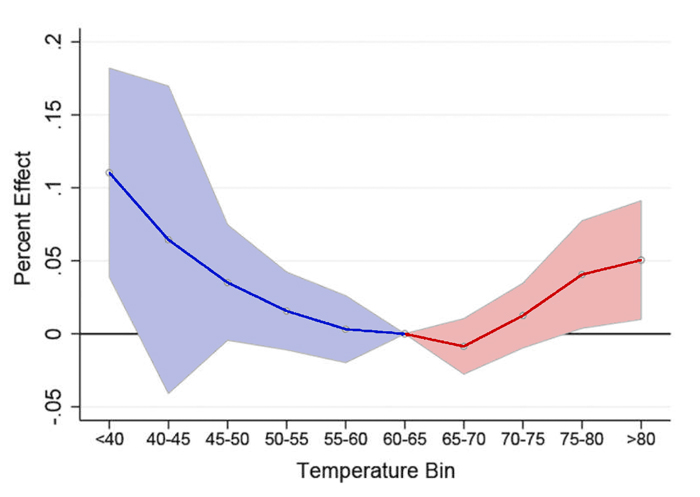| Tweet | Follow @co2science |
Paper Reviewed
White, C. 2017. The dynamic relationship between temperature and morbidity. Journal of the Association of Environmental and Resource Economists 4: 1155-1198.
Most of the literature examining the relationship between temperature and human health has focused on mortality effects, with far less attention being devoted to understanding the impact of temperature on human morbidity. The recent work of White (2017), however, goes a long way to filling that information void. Using daily hospital visit and meteorological data, the University of California, Santa Barbara researcher examined the dynamic relationship between temperature and morbidity in California over the period 2005-2014. And the results of his analysis were quite revealing.
Starting with the figure presented below, White determined that the 31-day cumulative impact of a cold day with a mean temperature under 40°F resulted in an 11% net increase in total morbidity (defined by the number of emergency department visits), which value rose to 17% when the cumulative impact was expanded another month (for the remainder of his analysis, however, White reverted back to a 31-day window, considering such relationships to represent a lower bound on the total net effect of temperature on morbidity).

Figure 1. Cumulative (one month) effect of temperature (°F) on emergency department visits in California (2005-2014). Shaded region represent 95% confidence intervals. Source: White (2017).
The most influential disease category driving cumulative cold temperature morbidity was that of respiratory (including influenza and pneumonia), which far exceeded any other cause and amounted to approximately 6 of the 8.5 increased hospital visits per 100,000 persons that were due to cold temperatures. Stratifying the effect of cold temperatures by age group, White further reports that the greatest risk of morbidity fell within the youngest age group (children under 5 years of age), which group experienced a 27.7% increase in hospital visits above the mean daily visit rate -- a value that was four times as large as that observed for the least affected group (non-elderly adults aged 25-64).
With respect to the warm end of the temperature spectrum, White found that the 31-day cumulative impact of a hot day (with mean temperature above 80°F) was to increase human morbidity by 5.1%. Several disease categories contributed to this overall relationship, including injuries, nervous system and genitourinary problems.
As with cold weather, hot weather morbidity was also influenced by age; and the effect was more pronounced in the youngest age categories, where morbidity risk was 8.6% and 9.5% for the under 5 and 5-14 age groups, which values are more than twice as large as the impacts on any other age group. Interestingly, the author also reported finding evidence of an early harvesting effect (an initial morbidity increase that is offset by a later decrease) on the elderly during hot days. The over 64 age group, for example, experienced an initial contemporaneous increase of 3.7% in morbidity on days where the mean temperature was above 80°F. However, the cumulative morbidity effect fell to 2.7% at the end of 31 days.
White also calculated the healthcare cost impacts associated with both hot and cold morbidity, reporting that a day over 80°F mean temperature is associated with an approximate $8,000 increase in hospital costs per 100,000 persons, whereas cost impacts from a mean daily temperature below 40°F amount to a much larger $12,000 per 100,000 people.
Lastly, White also estimated the potential effects of climate change on human morbidity and its associated healthcare costs using future temperature projections derived from climate model output produced under the IPCC's RCP8.5 greenhouse gas emission scenario. Results of that exercise revealed "the effects of climate change on hospital visits and costs in California to be negligible."
Considering all of the author's findings, it is clear that colder weather is a far greater risk to human health than are warm temperatures.
Posted 16 February 2018



